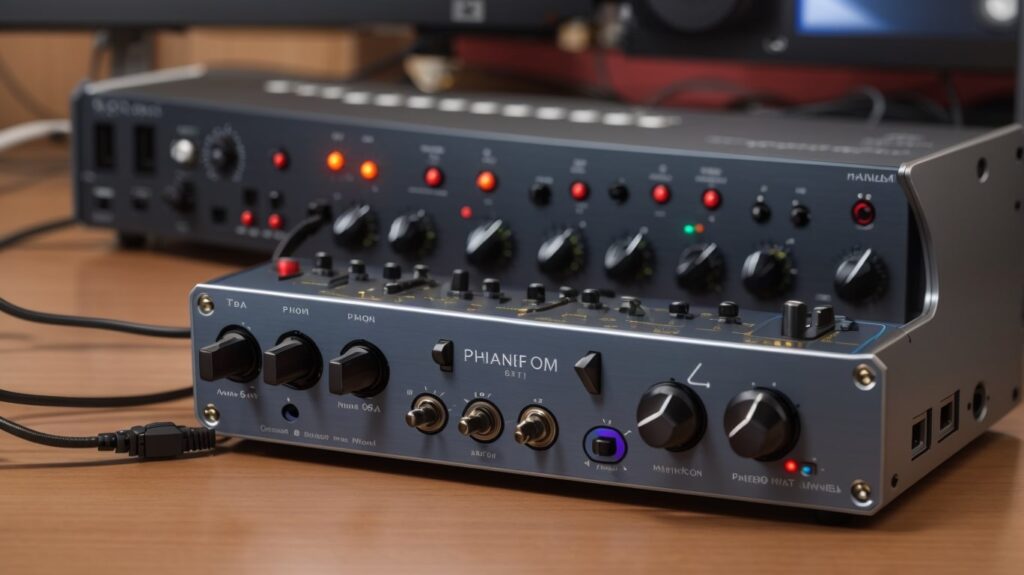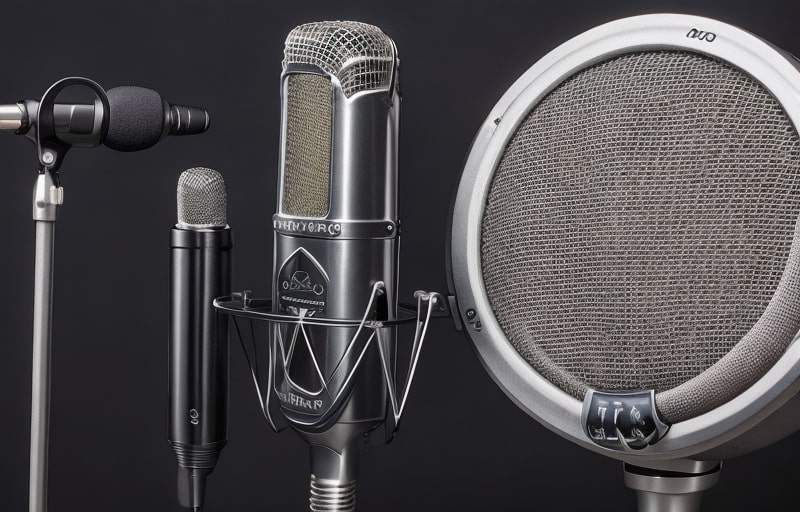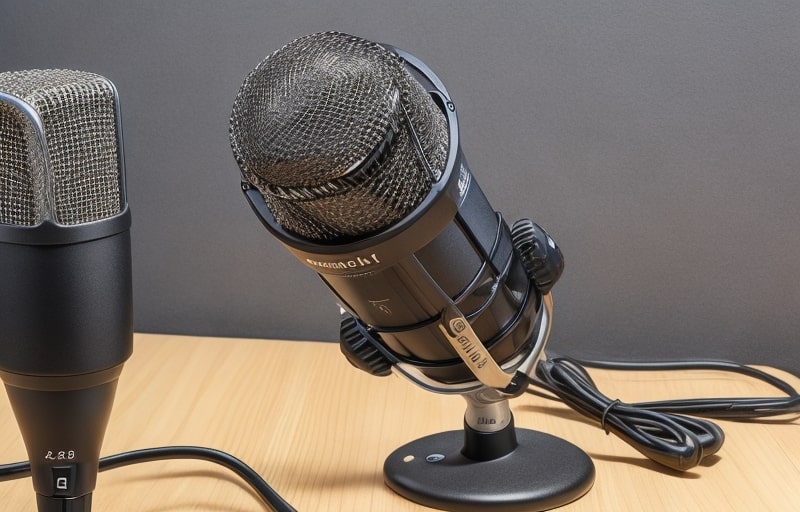Welcome to this blog post about an often asked question by audio enthusiasts and podcasters – “Can you use a condenser mic without phantom power?” Understanding the technicalities of audio equipment is essential for producing high-quality sound.
One critical aspect of this is knowing the role of phantom power in operating condenser microphones.
This post will delve into the basics of condenser mics, the necessity of phantom power, and what happens if you try to use one without it. Let’s dive deep and clear all the ambiguities surrounding this topic!
Unmasking the Phantom: What is Phantom Power?

Before we delve into the intricacies of using condenser microphones sans phantom power, let’s unravel the enigma behind this electrifying term.
Phantom power is an essential facet of audio recording, akin to the life force that powers your devices.
It’s a method of delivering DC voltage (usually 48 volts) through the microphone cable to power condenser microphones.
Condenser mics, renowned for their sensitivity and accuracy, are engineered with a diaphragm that vibrates in response to sound waves.
This diaphragm requires an external energy source to function optimally, and that’s where phantom power comes into play. It charges the microphone’s internal electronics, enabling it to capture sound with remarkable precision.
The Sonic Enchantment: Importance of Phantom Power in Audio Recording
Now that we’ve shed light on the phantom’s identity, let’s delve into why it’s indispensable in the realm of audio recording.
1. Enhancing Microphone Sensitivity
Phantom power serves as the lifeblood of condenser microphones. It empowers them to exhibit a level of sensitivity and responsiveness that’s unmatched.
This heightened sensitivity allows condenser mics to capture subtle nuances in audio, making them ideal for studio recording, vocals, and acoustic instruments.
Imagine a singer’s gentle whisper or the delicate plucking of guitar strings – without phantom power, these nuances would fade into obscurity, leaving your recordings devoid of the magic that brings them to life.
2. Reducing Self-Noise
Condenser microphones are known for their low self-noise, which means they produce minimal unwanted sound artifacts.
Phantom power plays a pivotal role in this by ensuring a consistent and clean power supply. Without it, condenser mics may succumb to noise interference, resulting in hisses and pops that tarnish your recordings.
3. Enabling Versatility
Phantom power is not exclusive to condenser mics. Many other professional audio equipment, such as active direct boxes and certain microphones, rely on it as well.
Its widespread availability and standardized voltage make it a versatile asset in the audio world, allowing various devices to coexist seamlessly in your recording setup.
Breaking the Chains: Do Condenser Mics Always Require Phantom Power?

Now, let’s address the elephant in the recording studio – can you use a condenser microphone without phantom power?
The answer, my fellow sound aficionados, is both a yes and a no, depending on the specific microphone and scenario.
1. Dynamic Duo: Dynamic Microphones
While condenser microphones thrive on phantom power, their dynamic counterparts are a different breed.
Dynamic microphones are robust and self-powered, meaning they don’t rely on external voltage to function. If you’re using a dynamic mic, you can happily omit phantom power from the equation.
2. Passive vs. Active Condenser Mics
Within the realm of condenser microphones, a distinction exists between passive and active models.
Passive condenser mics, though less common, can operate without phantom power, but they may require a battery or external power source.
Active condenser mics, on the other hand, rely heavily on phantom power for optimal performance.
Attempting to use them without phantom power could yield lackluster results, with reduced sensitivity and overall audio quality.
Check out these articles to find out which microphones Best Quick Review endorses for studio recording, vocals, and acoustic instruments: Best Condenser Mic Under $200 for Studio-Quality Sound
3. Phantom Power Alternatives
If you find yourself in a situation where phantom power is unavailable, fear not – there are alternative solutions.
Some audio interfaces and mixers offer built-in preamps with switchable phantom power. This allows you to use condenser mics without needing an external phantom power supply.
Additionally, you can explore battery-powered phantom power supplies or portable preamps, providing the necessary voltage to your condenser mic when the traditional phantom power source is absent.
Find comprehensive information on the Condenser Mic Not Working in my article: Why is My Condenser Mic Not Working? Common Issue & Solution
How to Provide Phantom Power to Your Condenser Mic

Before we venture into the uncharted territory of using a condenser mic without phantom power, let’s establish why this power source is crucial for these microphones.
A Condenser Mic Needs to be Powered by a Phantom Power Supply
Condenser microphones are renowned for their sensitivity and ability to capture intricate audio details.
This sensitivity, however, comes at a cost – they require external power to operate effectively.
Phantom power, typically delivered at +48V, is the lifeblood of these microphones. It charges the microphone’s internal capacitor, allowing it to convert sound waves into electrical signals.
Exploring the +48V Phantom Power Source
Phantom power, often provided at +48 volts, is a standard in the audio recording industry.
It’s usually delivered through XLR cables that connect your microphone to a mixer or audio interface.
This steady stream of power ensures the microphone’s diaphragm remains charged and ready to capture sound accurately.
Phantom Power Options from an Audio Mixer
Many audio mixers come equipped with built-in phantom power supplies. When you connect your condenser microphone to such a mixer, you can rest assured that it will receive the necessary power.
This makes mixers a popular choice for those looking to record audio with condenser microphones.
Using USB Audio Interfaces for Phantom Power
If you prefer a more compact and versatile setup, USB audio interfaces are an excellent choice.
These devices often feature phantom power options, allowing you to connect your condenser mic directly to your computer.
It’s a convenient solution for home studios and mobile recording setups.
Alternatives: External Battery Packs and USB Adapters
In situations where you need phantom power but lack access to a mixer or audio interface, external battery packs and USB adapters can come to the rescue.
These devices can provide the required +48V power to your condenser microphone, ensuring it functions as intended.
Can You Use a Condenser Mic Without Phantom Power?

A condenser microphone needs power to operate, and this is usually supplied by a phantom power supply.
Phantom power is a way to provide power to the microphone through the same cable that carries the audio signal.
Most condenser mics require phantom power, typically 48 volts, to power their internal electronics and charge the microphone capsule.
However, there are some condenser microphones that have their own power supply and don’t require phantom power.
These are often vintage or specialty microphones that have a dedicated power supply unit that must be connected between the microphone and the preamp or mixer.
So, in general, you will need phantom power to operate a condenser microphone, unless it is a special model with its own power supply.
If you try to use a condenser mic without the required phantom power, it either will not work at all, or the audio output will be extremely weak and poor quality.
Explore my articles for a more in-depth understanding of Condenser Mic Make You Sound Better: Does a Condenser Mic Make You Sound Better? Elevate Sound
Condenser Mic Usage Without an Interface or Mixer
If you’re in a bind and have no access to phantom power, you can still use your condenser microphone.
However, you’ll need to compromise on audio quality and functionality. Without phantom power, your condenser mic essentially becomes a glorified paperweight.
It won’t be able to capture audio as accurately or crisply as it would with the proper power source.
Powering a Condenser Mic with Batteries: Is it Possible?
In some rare cases, condenser microphones come equipped with battery compartments.
These batteries can temporarily replace the need for phantom power. However, this solution is far from ideal.
Batteries drain quickly, and the microphone’s performance may suffer as the voltage decreases. It’s a makeshift solution at best.
Understanding Phantom Power for Dynamic Mics
While condenser microphones heavily rely on phantom power, it’s essential to note that dynamic microphones do not.
Dynamic mics operate differently, using electromagnetic induction to generate electrical signals.
They are less sensitive but more durable, making them suitable for various applications.
How is Phantom Power Supplied in Audio Recording?
To gain a deeper understanding of phantom power, let’s explore how it is supplied in the world of audio recording.
In most setups, phantom power originates from a mixing console or audio interface.
When you connect your condenser microphone to one of these devices using an XLR cable, the necessary power is transmitted through the cable’s conductors.
This power travels to the microphone’s internal circuitry, ensuring it functions optimally.
FAQs About Can You Use a Condenser Mic Without Phantom Power
What happens if you use a condenser mic without phantom power?
Without phantom power, a condenser mic won’t function.
Phantom power provides the necessary voltage to polarize the mic’s diaphragm, enabling it to capture sound. Without it, you’ll hear little to no audio signal.
Do small condenser mics need phantom power?
Yes, small condenser mics still require phantom power.
Phantom power is essential for polarizing the diaphragm in all condenser mics, regardless of their size, to convert sound into an electrical signal.
Why do condenser mics need phantom power?
Condenser mics need phantom power to maintain an electric charge on their diaphragms.
This polarization enables them to capture subtle sound details accurately and convert them into usable audio signals with high sensitivity.
Do I need phantom power for a USB condenser mic?
No, USB condenser mics do not need phantom power.
They draw power directly from the USB connection to your computer, eliminating the need for an external phantom power source.
Which type of microphone should never receive phantom power?
Dynamic microphones should never receive phantom power.
Applying phantom power to them can damage their internal components and alter their sound characteristics.
Which type of microphone always requires phantom power?
Condenser microphones always require phantom power.
It is essential to energize their diaphragms and make them functional, ensuring they capture audio with high fidelity.
Do condenser mics require phantom power 48V?
Yes, most condenser mics require phantom power rated at 48 volts (48V).
This standardized voltage level ensures compatibility with a wide range of condenser microphones.
Is it bad to leave a condenser mic on all the time?
Leaving a condenser mic on all the time isn’t advisable. It can lead to unnecessary wear and tear on the microphone, reduce its lifespan, and potentially introduce unwanted noise into your recordings. It’s best to power it off when not in use.
Does phantom power make the mic sound better?
Phantom power doesn’t directly improve the sound quality of a microphone.
It’s necessary to power condenser mics but doesn’t enhance their audio performance.
Sound quality depends on other factors like mic design, capsule quality, and acoustic environment.
Conclusion
Using a condenser microphone without phantom power is not possible, as it relies on this power to function.
Phantom power is a DC voltage (usually 48V) supplied by the mixer or audio interface to power the internal electronics of the condenser mic.
Without it, the microphone cannot produce a signal.
Dynamic microphones, on the other hand, do not require phantom power.
However, it’s always important to check the specifications of your equipment to ensure compatibility.
In conclusion, if you plan to use a condenser microphone, you must ensure you have a source of phantom power.
